International Journal of Image, Graphics and Signal Processing @ijigsp
Статьи журнала - International Journal of Image, Graphics and Signal Processing
Все статьи: 1146
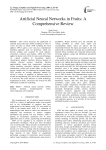
Artificial Neural Networks in Fruits: A Comprehensive Review
Статья научная
This review discusses the application of artificial neural networks (ANN) modeling in fruits. It covers all fruits in which ANN modeling has been applied. ANN is quite a new and easy computational modeling approach used for prediction, which has become popular and accepted by food industry, researchers, scientists and students. ANNs have been applied in almost every field of science and technology, viz., speech synthesis & recognition, pattern classification, adaptive interfaces between humans & complex physical systems, clustering, function approximation, image data compression, non-linear system modeling, associative memory, combinatorial optimization, control and several others, as they have proved valuable tools for obtaining the required output. ANN provides an exciting alternative method for solving a variety of problems in different areas of science and engineering. The aim of this communication is to discover the recent advances of ANN technology implemented in fruits, and discuss the critical role that ANN plays in predictive modelling.
Бесплатно
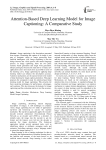
Attention-based deep learning model for image captioning: a comparative study
Статья научная
Image captioning is the description generated from images. Generating the caption of an image is one part of computer vision or image processing from artificial intelligence (AI). Image captioning is also the bridge between the vision process and natural language process. In image captioning, there are two parts: sentence based generation and single word generation. Deep Learning has become the main driver of many new applications and is also much more accessible in terms of the learning curve. Image captioning by applying deep learning model can enhance the description accuracy. Attention mechanisms are the upward trend in the model of deep learning for image caption generation. This paper proposes the comparative study for attention-based deep learning model for image captioning. This presents the basic analyzing techniques for performance, advantages, and weakness. This also discusses the datasets for image captioning and the evaluation metrics to test the accuracy.
Бесплатно
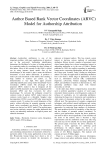
Author Based Rank Vector Coordinates (ARVC) Model for Authorship Attribution
Статья научная
Authorship attribution is one of the important problem, with many applications of practical use in the real-world. Authorship identification determines the likelihood of a piece of writing produced by a particular author by examining the other writings of that author. Most of the research in this field is carried out by using instance based model. One of the disadvantages of this model is that it treats the different documents of each author differently. It produces a matrix per each document of the author, thus creating a huge number of matrices per author, i.e. the dimensionality is very high. This paper presents authorship identification using Author based Rank Vector Coordinates (ARVC) model. The advantage of the proposed ARVC model is that it integrates all the author's profile documents into a single integrated profile document (IPD) and thus overcomes the above disadvantage. To overcome the ambiguity created by common words of authors ARVC model removes the common words based on a threshold. Singular value decomposition (SVD) is used on IPD after removing the common words. To reduce the overall dimension of the matrix, without affecting its semantic meaning a rank-based vector coordinates are derived. The eigenvector features are derived on ARVC model. The present paper used cosine similarity measure for author attribution and carries out authorship attribution on English poems and editorial documents
Бесплатно
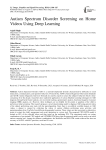
Autism Spectrum Disorder Screening on Home Videos Using Deep Learning
Статья научная
Autism Spectrum Disorder (ASD) is a neurodevelopmental disorder characterized by difficulty in social interactions, communication, and repetitive behaviors. Protocols like ADOS (Autism Diagnostic Observation Schedule) and ADI-R (Autism Diagnostic Interview Revised) are used by experts to assess the subject’s behavior which is time-consuming. Over the decade, researchers have studied the application of various Machine Learning techniques for ASD diagnosis through facial feature analysis, eye movement tracking, questionnaire analysis, functional magnetic resonance imaging (fMRI) analysis, etc. However, these techniques are not helpful for the parent or guardian of the child to perform an initial screening. This research proposes a novel deep learning model to diagnose ASD using general videos of the subject performing some tasks with the parent/guardian. Since there is no publicly available dataset on ASD videos, a dataset is created by collecting the videos of autistic children performing some activities with parents/guardians from YouTube from different demographic locations. These videos are then converted to skeletal key points to extract the child's engagement and social interaction in a given task. The proposed CNN-LSTM model is trained on 80% of the collected videos and then tested on the remaining 20%. The experiment results on various combinations of pre-trained CNN models and LSTM/BiLSTM show that the proposed model can be used as an initial autism screening tool. Among the different combinations, the MobileNet and Bi-LSTM combo achieved the best test accuracy of 84.95% with 89% precision, recall and F1-score.
Бесплатно
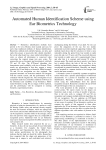
Automated Human Identification Scheme using Ear Biometrics Technology
Статья научная
Biometrics identification methods have proved to be very efficient, more natural and easy for users than traditional methods of human identification. Biometrics methods truly identify humans, not keys and cards they posses or passwords they should remember. Ear on the other hand, has a more uniform distribution of color, so almost all information is conserved when converting the original image into gray scales. We propose the ear as a biometric and investigate it with both 2D and 3D data. The ICP-based algorithm also demonstrates good scalability with size of dataset. These results are encouraging in that they suggest a strong potential for 3D ear shape as a biometric. Multi-biometric 2D and 3D ear recognition are also explored. The proposed automatic ear detection method will integrate with the current system, and the performance will be evaluated with the original one. The investigation of ear recognition under less controlled conditions will focus on the robustness and variability of ear biometrics. Multi-modal biometrics using 3D ear images will be explored, and the performance will be compared to existing biometrics experimental results.
Бесплатно
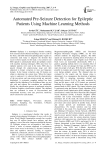
Automated Pre-Seizure Detection for Epileptic Patients Using Machine Learning Methods
Статья научная
Epilepsy is a neurological disorder resulting from unusual electrochemical discharge of nerve cells in the brain, and EEG (Electroencephalography) signals are commonly used today to diagnose the disorder that occurs in these signals. In this study, it was aimed to use EEG signals to automatically detect pre-epileptic seizure with machine learning techniques. EEG data from two epileptic patients were used in the study. EEG data is passed through the preprocessing stage and then subjected to feature extraction in time and frequency domain. In the feature extraction step 26 features are obtain to determine the seizure time. When the feature vector is analyzed, it is observed that the characteristics of the pre-seizure and non-seizure period are unevenly distributed. A systematic sampling method has been applied for this imbalance. For the balanced data, two test sets with and without Eta correlation are established. Finally, the classification process is performed using the k-Nearest Neighbor classification method. The obtained data are evaluated in terms of Eta-correlated and uncorrelated accuracy, error rate, precision, sensitivity and F-criterion for each channel.
Бесплатно
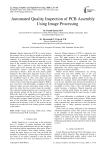
Automated Quality Inspection of PCB Assembly Using Image Processing
Статья научная
Quality inspection of PCB is a crucial stage in the assembly line as it provides an insight on whether the board works correctly or not. When the inspection is done manually, it is susceptible to human errors and is time consuming. The boards should thus be inspected at every stage of the assembly line and the process should be dynamic. This is achieved in this work through three crucial stages in the assembly line and by replacing the conventional manual inspection by using image processing to obtain a faster and more precise quality inspection. The solder paste inspection consists of pre-processing using blue plane conversion, comparing with the unsoldered board in blue color plane and post processing using overlay. The X-ray inspection basically consists of pre- processing the captured image by RGB to gray conversion with thresholding, comparing with the expected image and post processing using overlay to show the shorts that has occurred along the assembly. The conformal coating inspection uses conversion of the blue intensity emitted off the board under UV light to RGB scale. Each of the algorithms were tested using 48 actual in-production boards from Vinyas IT Pvt Ltd, a PCB assembly company based in Mysore. The processing time of the algorithms were found to be less than 2 seconds with an accuracy of 85.7%. The system was also found to be cost effective over existing systems available in the market.
Бесплатно
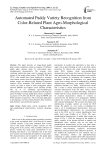
Automated paddy variety recognition from color-related plant agro-morphological characteristics
Статья научная
The paper presents an image-based paddy plant variety recognition system to recognize 15 different paddy plant varieties using 18 color-related agro-morphological characteristics. The k-means color clustering method has been used to segment the target regions in the paddy plant images. The RGB, HSI and YCbCr color models have been employed to construct color feature vectors from the segmented images and the feature vectors are reduced using Principal Component Analysis (PCA) technique. The reduced color feature vectors are used as input to back propagation neural network (BPNN) and support vector machine (SVM). The set of six combined agro-morphological characteristics recorded during maturity growth stage has given the highest average paddy plant variety recognition accuracies of 91.20% and 86.33% using the BPNN and SVM classifiers respectively. The work finds application in developing a tool for assisting botanists, Rice scientists, plant breeders, and certification agencies.
Бесплатно
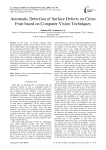
Automatic Detection of Surface Defects on Citrus Fruit based on Computer Vision Techniques
Статья научная
In this paper, we present computer vision based technique to detect surface defects of citrus fruits. The method begins with background removal using k-means clustering technique. Mean shift segmentation is used for fruit region segmentation. The candidate defects are detected using threshold based segmentation. In this stage, it is very difficult to differentiate stem-end from actual defects due to similarity in appearance. Therefore, we proposed a novel technique to differentiate stem-end from actual defects based on the shape features. We conducted experiments on our citrus data set captured in controlled environment. The experiment results demonstrate that our technique outperforms the existing techniques.
Бесплатно
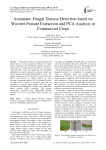
Статья научная
This paper describes automatic detection and classification of visual symptoms affected by fungal disease. Algorithms are developed to acquire and process color images of fungal disease affected on commercial crops like chili, cotton and sugarcane. The developed algorithms are used to preprocess, segment, extract and reduce features from fungal affected parts of a crop. The feature extraction is done with discrete wavelet transform (DWT) and features are further reduced by using Principal component analysis (PCA). Reduced features are then used as inputs to classifiers and tests are performed to classify image samples. We have used statistical based Mahalanobis distance and Probabilistic neural network (PNN) classifiers. The average classification accuracies using Mahalanobis distance classifier are 83.17% and using PNN classifier are 86.48%
Бесплатно
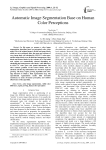
Automatic Image Segmentation Base on Human Color Perceptions
Статья научная
In this paper we propose a color image segmentation algorithm based on perceptual color vision model. First, the original image is divide into image blocks which are not overlapped; then, the mean and variance of every image back was calculated in CIEL*a*b* color space, and the image blocks were divided into homogeneous color blocks and texture blocks by the variance of it. The initial seed regions are automatically selected depending on calculating the homogeneous color blocks' color difference in CIEL*a*b* color space and spatial information. The color contrast gradient of the texture blocks need to calculate and the edge information are stored for regional growing. The fuzzy region growing algorithm and coloredge detection to obtain a final segmentation map. The experimental segmentation results hold favorable consistency in terms of human perception, and confirm effectiveness of the algorithm.
Бесплатно
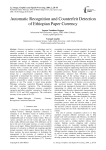
Automatic Recognition and Counterfeit Detection of Ethiopian Paper Currency
Статья научная
Currency recognition is a technology used to identify currencies of various countries. The use of automatic methods of currency recognition has been increasing due its importance in many sectors such as vending machine, railway ticket counter, banking system, shopping mall, currency exchange service, etc. This paper describes the design of automatic recognition of Ethiopian currency. In this work, we propose hardware and software solutions which take images of an Ethiopian currency from a scanner and camera as an input. We combined characteristic features of currency and local feature descriptors to design a four level classifier. The design has a categorization component, which is responsible to denominate the currency notes into their respective denomination and verification component which is responsible to validate whether the currency is genuine or not. The system is tested using genuine Ethiopian currencies, counterfeit Ethiopian currencies and other countries' currencies. The denomination accuracy for genuine Ethiopian currency, counterfeit currencies and other countries' currencies is found to be 90.42%, 83.3% and 100% respectively. The verification accuracy of our system is 96.13%.
Бесплатно
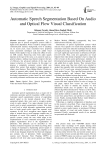
Automatic Speech Segmentation Based On Audio and Optical Flow Visual Classification
Статья научная
Automatic speech segmentation as an important part of speech recognition system (ASR) is highly noise dependent. Noise is made by changes in the communication channel, background, level of speaking etc. In recent years, many researchers have proposed noise cancelation techniques and have added visual features from speaker’s face to reduce the effect of noise on ASR systems. Removing noise from audio signals depends on the type of the noise; so it cannot be used as a general solution. Adding visual features improve this lack of efficiency, but advanced methods of this type need manual extraction of visual features. In this paper we propose a completely automatic system which uses optical flow vectors from speaker’s image sequence to obtain visual features. Then, Hidden Markov Models are trained to segment audio signals from image sequences and audio features based on extracted optical flow. The developed segmentation system based on such method acts totally automatic and become more robust to noise.
Бесплатно
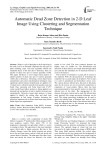
Automatic dead zone detection in 2-D leaf image using clustering and segmentation technique
Статья научная
Plant is a gift of almighty to the living being in the earth. Leaf is an essential component for any types of plant including crops, fruit and vegetables. Before the scheduled decay of the leaf due to deficiency there are patches of dead zone spot or sections generally visible. This paper introduces a novel image based analysis to identify patches of dead zone spot or sections generally visible due to deficiency. Clustering, colour object based segmentation and colour transformation techniques using significant salient features identification are applied over 12 plant leaves collected naturally from gardens and crop fields. Hue, saturation and Value based and L*a*b* colour model based object analysis is being applied over diseased leaf and portion of leaf to identify the dead zone automatically. Derivative based edge analysis is being applied to identify the outline edge and dead zone segmentation in leaf image. K-means clustering has played an important role to cluster dead zone using colour based object area segmentation.
Бесплатно
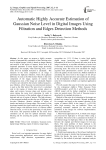
Статья научная
In this paper we propose a highly accurate method of automatically estimation of the Gaussian noise level in digital images, which is based on image filtering and analysis of the region of interest. Noise level is an important parameter to many digital image processing applications, for example, when removing noise. As the noise level its standard deviation is calculated. The selection of the noise component in an image is performed by high-pass filtration, where the Laplacian difference is used as the filter kernel. Based on the noise component of the image, regions of interest with homogeneous areas of the image are calculated. Region of interest are selected by the iterative method using low-pass filtration, where Gaussian two-dimensional function is used as the filter kernel. The noise level is calculated only in the regions of interest that contain almost no edges and textures, because edges and textures cause errors during the noise level estimation. In order to improve the accuracy of the method, edges of images are detected and out of region of interest. The high accuracy of the proposed method provides the use of high-pass and low-pass filtrations, iterative selection of region of interest and analysis of image edges. The accuracy of the developed method has been tested on the processing of 100 test images with different levels of software added Gaussian noise, as well as the processing of real photos with noise. The proposed method for the noise level estimation can be used for optimal automatic image filtering and for assessing the quality of photosensitive sensors.
Бесплатно
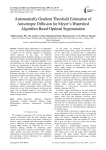
Статья научная
Medical image segmentation is a fundamental task in the medical imaging field. Optimal segmentation is required for the accurate judgment or appropriate clinical diagnosis. In this paper, we proposed automatically gradient threshold estimator of anisotropic diffusion for Meyer’s Watershed algorithm based optimal segmentation. The Meyer’s Watershed algorithm is the most significant for a large number of regions separations but the over segmentation is the major drawback of the Meyer’s Watershed algorithm. We are able to remove over segmentation after using anisotropic diffusion as a preprocessing step of segmentation in the Meyer’s Watershed algorithm. We used a fixed window size for dynamically gradient threshold estimation. The gradient threshold is the most important parameter of the anisotropic diffusion for image smoothing. The proposed method is able to segment medical image accurately because of obtaining the enhancement image. The introducing method demonstrates better performance without loss of any clinical information while preserving edges. Our investigated method is more efficient and effective in order to segment the region of interests in the medical images indeed.
Бесплатно
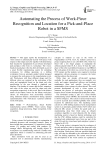
Automating the Process of Work-Piece Recognition and Location for a Pick-and-Place Robot in a SFMS
Статья научная
This paper reports the development of a vision system to automatically classify work-pieces with respect to their shape and color together with determining their location for manipulation by an in-house developed pick-and-place robot from its work-plane. The vision-based pick-and-place robot has been developed as part of a smart flexible manufacturing system for unloading work-pieces for drilling operations at a drilling workstation from an automatic guided vehicle designed to transport the work-pieces in the manufacturing work-cell. Work-pieces with three different shapes and five different colors are scattered on the work-plane of the robot and manipulated based on the shape and color specification by the user through a graphical user interface. The number of corners and the hue, saturation, and value of the colors are used for shape and color recognition respectively in this work. Due to the distinct nature of the feature vectors for the fifteen work-piece classes, all work-pieces were successfully classified using minimum distance classification during repeated experimentations with work-pieces scattered randomly on the work-plane.
Бесплатно
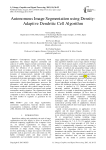
Autonomous Image Segmentation using Density-Adaptive Dendritic Cell Algorithm
Статья научная
Contemporary image processing based applications like medical diagnosis automation and analysis of satellite imagery include autonomous image segmentation as inevitable facility. The research done shows the efficiency of an adaptive evolutionary algorithm based on immune system dynamics for the task of autonomous image segmentation. The recognition dynamics of immune-kernels modeled with infinite Gaussian mixture models exhibit the capability to automatically determine appropriate number of segments in presence of noise. In addition, the model using representative density-kernel-parameters processes the information with much reduced space requirements. Experiments conducted with synthetic images as well as real images recorded assured convergence and optimal autonomous model estimation. The segmentation results tested in terms of PBM-index values have been found comparable to those of the Fuzzy C-Means (FCM) for the same number of segments as generated by our algorithm.
Бесплатно
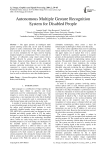
Autonomous Multiple Gesture Recognition System for Disabled People
Статья научная
The paper presents an intelligent multi gesture spotting system that can be used by disabled people to easily communicate with machines resulting into easement in day-to-day works. The system makes use of pose estimation for 10 signs used by hearing impaired people to communicate. Pose is extracted on the basis of silhouettes using timed motion history (tMHI) followed by gesture recognition with Hu-Moments. Signs involving motion are recognized with the help of optical flow. Based on the recognized gestures, particular instructions are sent to the robot connected to system resulting into an appropriate action/movement by the robot. The system is unique as it can act as a assisting device and can communicate in local as well as wide area to assist the disabled person.
Бесплатно
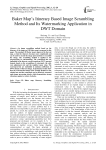
Baker Map's Itinerary Based Image Scrambling Method and Its Watermarking Application in DWT Domain
Статья научная
An image scrambling method based on the itinerary of the improved 3D Baker map is proposed in this paper. The standard 3D Baker map is improved by the tent map, so that the itinerary becomes more complicated and can be used to encode the image pixel positions to scramble the image. The scrambling method is applied to the preprocessing in watermarking. The watermark bits are embedded in the discrete wavelet transform (DWT) spectral domain based on the scrambling of watermark, the odd-even adjustment rule and the neighbor mean value. The watermark bits are embedded in medium coefficients in DWT domain of the host image. Experimental results show that the watermarked image looks visually identical to the original one and the watermark can be effectively extracted upon image processing attacks, which demonstrates strong robustness against a variety of attacks.
Бесплатно

